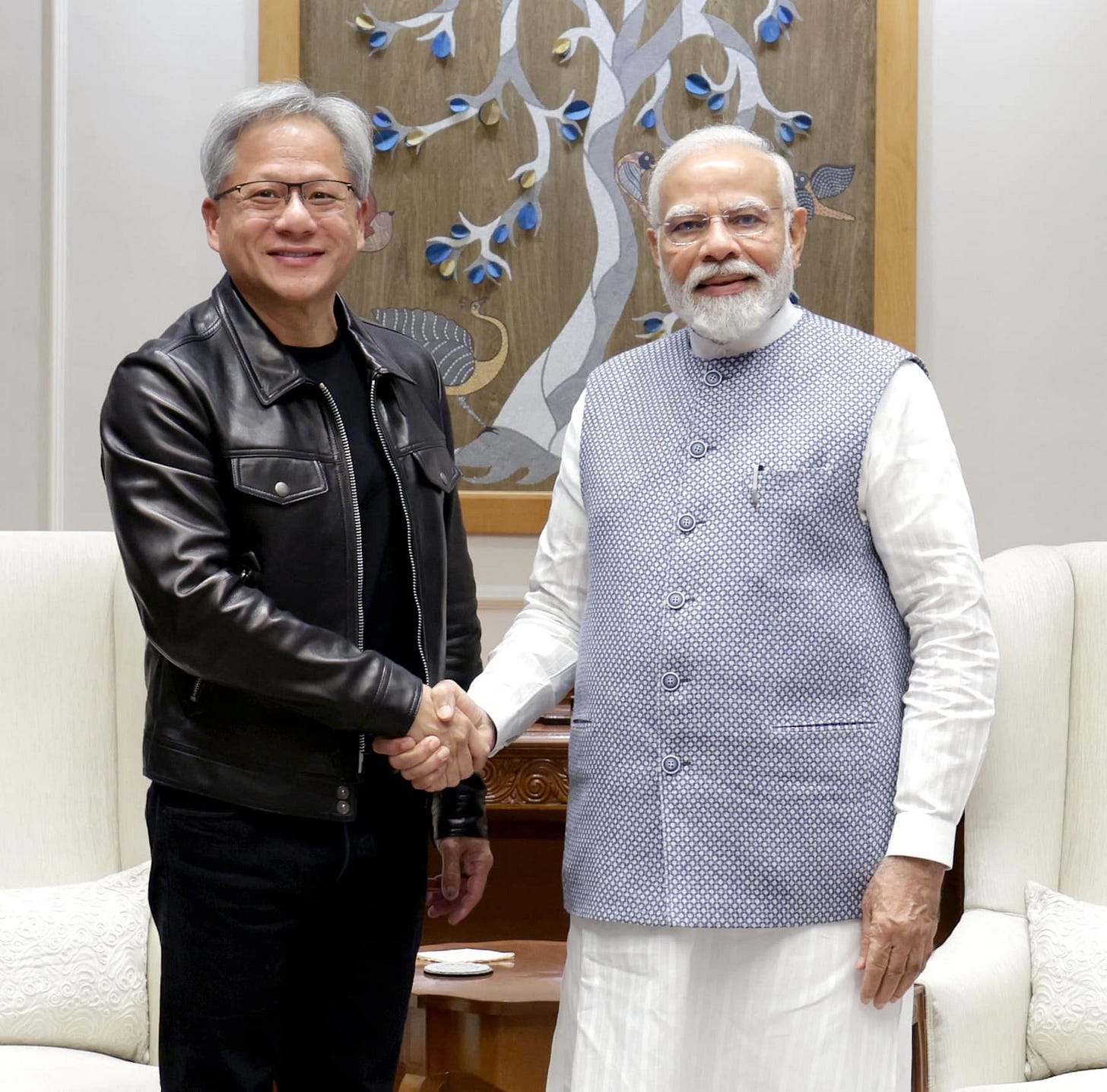After landing successfully on the moon, India now wants to be the world’s ‘Plan B’ as a center for global semiconductor ‘fabs’. These are where semiconductor chips are actually made rather than just designed, assembled or packaged. ‘Plan A’ of course today is Taiwan, the object of China and Xi Jiping’s long-held desires. Specifically, Taiwan Semiconductor (TSMC), that makes most of of the world’s chips, especially the AI kind by US chip giants Nvidia, Google, Apple and others.
Those latter companies do everything but actually make the chips in multi-billion dollar ‘fabs’ that take years and decades to build, staff, and run to standards that are not replicated in most human endeavors. Of course there are other companies like Samsung in South Korea, and many in Japan and other countries including the US that also make chips. But none at the scale and sophistication that TSMC does in Taiwan.
India has big ambitions in AI and beyond, as I’ve outlined earlier. As the NY Times explains in a lengthy piece on India’s chip ambitions titled “Modi Wants to Make India a Chip-Making Superpower. Can He?”:
”In his office in New Delhi, Ashwini Vaishnaw, the Indian minister of electronics and information technology, keeps a 12-inch disc of silicon semiconductor on the wall, gleaming like a platinum record beside a portrait of Prime Minister Narendra Modi. Its circuits, measured in nanometers and invisible to the human eye, may be the most sophisticated objects ever made. It vies with oil as one of most valuable traded goods on earth.”
“According to India’s government, the microprocessor chips that power all things digital will soon be fully made in India. It’s an ambition as unlikely as it is bold, and speaks volumes about Mr. Modi’s belief that he can propel India into the top tier of advanced technology manufacturing.”
“In July, a legion of fawning foreign businessmen lined up onstage behind Mr. Modi in his home state of Gujarat. About $10 billion in subsidies are at stake, ready to fund 50 percent or even 70 percent of any company’s outlay. Anil Agarwal, the chairman of Vedanta, a British mining and metals group, told reporters to expect “Vedanta made-in-India chips” by 2025.”
For this big dream, Prime Minister Modi is focusing on his home state of Gujarat, also the place where Mahatma Gandhi was born (and yours truly). The place there is Dholera:
“They have set their sights on a barren plain in Gujarat, Dholera (DOE-lay-rah), designated the future home of India’s first “semicon city.” It’s the size of Singapore. Slicing through sodden fields, ruler-straight new roads connect planning offices to power stations, freshwater canals from a diverted river and the gargantuan outline, traced in the dust, of an international airport. Dholera’s vast grid is otherwise virtually empty.”
The odds against are high:
“Today nearly all cutting-edge logic chips are made in Taiwan. As anxieties about China flare, and chips become more integral to every kind of technology, that seems increasingly risky to buyers and sellers alike. The Taiwan Semiconductor Manufacturing Company, founded in 1987 by the chip legend Morris Chang, has been struggling to help America get its own fabrication plants or “fabs” going in Arizona, with help from President Biden’s subsidy-infused CHIPS Act.”
“India has no history of fabbing chips and virtually none of the hyperspecialized engineers and equipment needed to start. Still, it says it will make them hear — and soon. It took TSMC and other Taiwanese companies decades, driven by government spending and countless billions in capital investment, to get where they are.”
“Since last October, when the United States decided to hobble the Chinese chip industry’s access to Western tools and workers, China has invested heavily on its own chip makers, vastly more than India has to spend on its companies.”
“Mr. Agarwal of Vedanta, the conglomerate that hopes to launch India’s first semiconductor foundry, believes he can start making chips in two and a half years. To lead the charge he has hired David Reed, a veteran of chip-making firms around the globe including, like Mr. Chang, Texas Instruments, the American company that once was a world beater in chips.”
The critical ingredient here besides the billions in subsidies, and the government attempt to clear big space and industrial infrastructure to make chips, is of course massive amounts of young, trained talent:
“India graduates more than 1.4 million engineers a year, including many of the highest quality, just as Taiwan is running short of fresh talent.”
US companies are also focused on India, including Apple, Nvidia, AMD and many others. As highlighted by Analytics India Magazine (AIM) recently:
“Last week, NVIDIA CEO Jensen Huang visited India and made some big announcements. The company partnered with major Indian companies such as Tata, Reliance and Infosys. Under this partnership, NVIDIA will deliver AI computing infrastructure and platforms to these companies for developing AI solutions.
“India, though a small AI market, contributes 16% of global AI talent, ranking among the top three talent producers worldwide, surpassing its own demand. With a legacy of exporting tech talent globally, India produces more talent than it consumes.”
“I would like to accelerate the building of AI infrastructure here in India. You have your own data, lots and lots of data. You also have very diverse languages. You have the great talent of computer scientists,” said Huang during the press meet.”
Nvidia is cultivating the developer talent (all important, as outlined), in India:
“NVIDIA began operations in India in 2004 in Bangalore, almost two decades ago. India is now home to four engineering development centers in India — in Gurugram, Hyderabad, Pune and Bengaluru — and there are now more than 3,800 NVIDIANs in India.”
“In addition, there are more than 320,000 India-based developers in NVIDIA’s developer program. NVIDIA’s CUDA parallel programming platform is downloaded roughly 40,000 times a month in India, and NVIDIA estimates there are 60,000 experienced AI CUDA developers in India.”
I highlight all this because chips, especially the advanced ones, are at the heart of how the world works of course, and critical to where the world wants to go with the AI Tech Wave. And as I’ve outlined before, ‘Threading the Needle’ with China remains the biggest head-wind issue for the US and the world.
I’m glad to see the US make every effort to work with China, while figuring out alternative options for diversification. Just this week saw Senator Chuck Schumer leading the fourth senior US delegation to China after recent trips by Commerce Secretary Raimondo, Secretary of State Blinken, Treasury Secretary Yellen and Special Presidential Envoy for Climate John Kerry. And of course China’s recent shot across the bow against the largest US company doing business in China, Apple.
So if India wants to take a shot at doing the very, very difficult, and deploy resources into semiconductor fabs, “Welcome to the Party, pal”, in the immortal words of John McClane. Stay tuned.
(NOTE: The discussions here are for information purposes only, and not meant as investment advice at any time. Thanks for joining us here)








